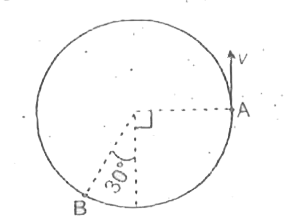A particle whose mass is 2 kg moves with a speed of 44 m/s on a curved path. The resultant force acting on the particle at a particular point of the curve is 30 N at 60∘ to the tangent to the curve, as shown in fig. At the point, find (a) the radius of curvature of the curve and (b) the tangential acceleration of the particle.

The correct Answer is:(a) 149m (b) 7.5m/s2
Step by step video & image solution for A particle whose mass is 2 kg moves with a speed of 44 m/s on a curved path. The resultant force acting on the particle at a particular point of the curve is 30 N at 60^(@) to the tangent to the curve, as shown in fig. At the point, find (a) the radius of curvature of the curve and (b) the tangential acceleration of the particle. by Physics experts to help you in doubts & scoring excellent marks in Class 12 exams.
Updated on:21/07/2023Topper's Solved these Questions
- CIRCULAR MOTIONBOOK - RESNICK AND HALLIDAYCHAPTER - CIRCULAR MOTIONEXERCISE - PRACTICE QUESTIONS(SINGLE CORRECT CHOICE TYPE)
40 Videos
- CIRCULAR MOTIONBOOK - RESNICK AND HALLIDAYCHAPTER - CIRCULAR MOTIONEXERCISE - PRACTICE QUESTIONS(MORE THAN ONE CORRECT CHOICE TYPE)
6 Videos
- CIRCULAR MOTIONBOOK - RESNICK AND HALLIDAYCHAPTER - CIRCULAR MOTIONEXERCISE - CHECK POINTS
6 Videos
- CIRCUITSBOOK - RESNICK AND HALLIDAYCHAPTER - CIRCUITSEXERCISE - Practice Questions (Integer Type)
3 Videos
- CURRENT AND RESISTANCEBOOK - RESNICK AND HALLIDAYCHAPTER - CURRENT AND RESISTANCEEXERCISE - Practice Questions (Integer Type)
3 Videos
Similar Questions
Knowledge Check
A particle of mass 1 kg is moving in SHM with an amplitude 0.02 m and a frequency of 60 Hz. The maximum force (in N) acting on the particle is
A188 π2B144 π2C288 π2DNone of the aboveThe displacement time curve of a particle is shown in the figure. The external force acting on the particle is :
 AActing at the beginning part of motionBZeroCNot zeroDNone of these
AActing at the beginning part of motionBZeroCNot zeroDNone of theseA particle of mass 1 kg is moving in SHM with path length 0.01 m and a frequency of 50 Hz. The maximum force in newton, acting on the particle is
A150π2B200π2C100π2D50π2
Figure shows the total acceleration and velocity of a particle moving clockwise in a circle of radius 2.5 m at a given instant of time. At this instant, Find: (i) the radial acceleration, (ii) the speed of the particle and (iii) its tangential acceleration.

View SolutionA car of mass kg rounds a curve of radius 250 m at 90 km/h. Find the centripetal force acting on it .
View SolutionA particle of mass 2 kg is moving in circular path with constant speed 20 m/s. The magnitude of change in velocity when particle travels from A to P will be

View SolutionA particles of mass m moving in a circle of radius r with unform speed v. The force F acting on a particle is proportional ot mavbrc. Find the values of a, b and c.
View SolutionA car of mass 1500 kg rounds a curve of radius 250 m , at 90 km / hour . What is the centripetal force acting on it ?
View Solution

